Counterpoint Research and a key group of industry executives will talk about important battery trends at its Innovation Talk: Powering Up Smartphone Batteries With Features and Material Innovation webinar – to be recorded on February 18 (National Battery Day in honor of Alessandro Volta) with the event streamed on February 24.
In addition to current technologies and the ever-increasing need for bigger batteries, the panel will also discuss how OEMs are optimising for longer life, faster charging, better overall user experience as well as the emergence of new materials technology which is already bringing incredible improvements to battery performance.
OEMs and component manufacturers today employ various methods to optimise battery performance, but power demands from the latest feature rich smartphones sporting bigger, brighter screens are pushing capacity requirements to the limit.
According to Counterpoint Research’s latest Monthly Smartphone Sales Tracker, the share of large, 4,000mAh and above batteries being provisioned within smartphones continues to increase, and is likely to rise above 80% during 1H 2022.

Source: Counterpoint Monthly Smartphone Sales Tracker, January 2022.
“Different manufacturers take different approaches, but it’s interesting to see the disparity between Android and iOS, which requires smaller batteries all things being equal. It makes the point that hardware-software integration is one of the keys to managing power consumption,” observes Peter Richardson, VP of Research at Counterpoint.
Xiaomi’s Chief Business Officer Raghu Reddy sees battery life as critical but notes, “With increasing content consumption due to modern-day usage and lifestyle, users are always on a lookout for devices that offer top-of-the-line specifications and features. These devices consume more power and drain batteries faster, resulting in increased charging times. To solve this problem for our users, we focus on fast charging with our 120W Hypercharge technology, which can charge your smartphone in about 15-17 minutes.”
Josh Warner, Director of Product Management for Qualcomm Technologies, Inc. works closely with vendors like Xiaomi to enable the industry-leading Qualcomm Quick Charge™ 5 solution. “Delivering fast charging capabilities is a priority, but there are also other elements. Keeping temperatures down, improving overall efficiency, packing more power into the battery, and wireless charging – these are the things our customers need when it comes to their devices’ battery experience.”
“Our testing protocols reflect both the vendor and consumer shift that’s taken place in terms of how battery experience is viewed. Autonomy, charging speeds, efficiency – these all play into our overall scores and our aim is to help guide OEMs to enhance the consumer experience,” says Olivier Simon, Deputy CTO & Battery Director at DXOMARK. “Ultimately, no power, no experience. But our job is to decrypt each element to help bring a better appreciation of the final picture.”
Arguably the most exciting area in battery tech has been around recent advances in materials technology which are delivering on step-change improvements to today’s lithium-ion batteries.
“Better batteries are the key to unlocking the next generation of innovation in smartphones,” states Sila’s Craig Weich, VP of Business Development. “Typically, batteries take up half the space and account for half the weight of a phone, which limits space for other components. We’ve developed next-gen silicon anode materials that drop into existing battery manufacturing processes and enable higher energy density. This allows phone makers to add features like better cameras, 5G network access, and fast charge without compromising form factors, battery life, or performance metrics.”




















